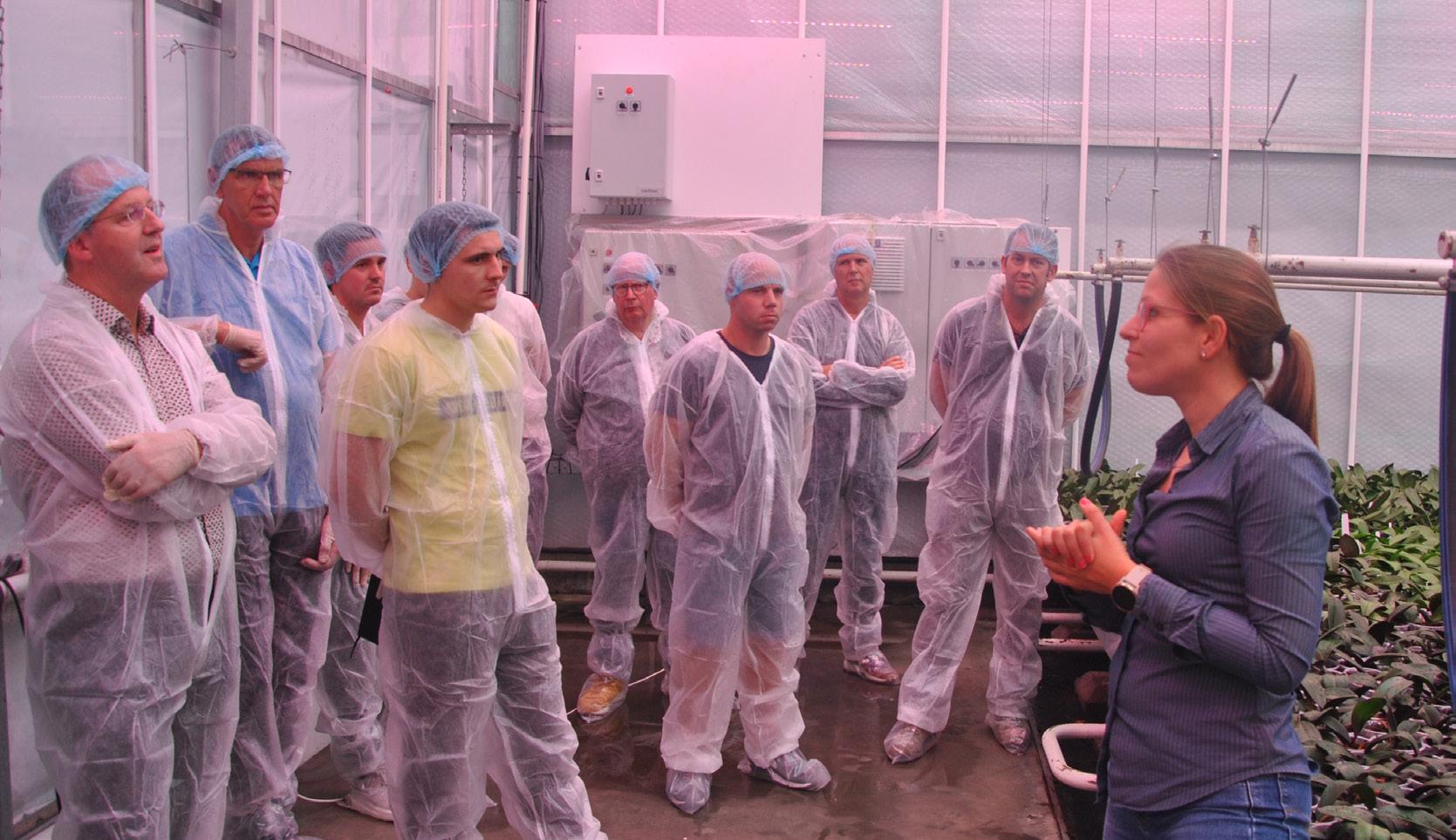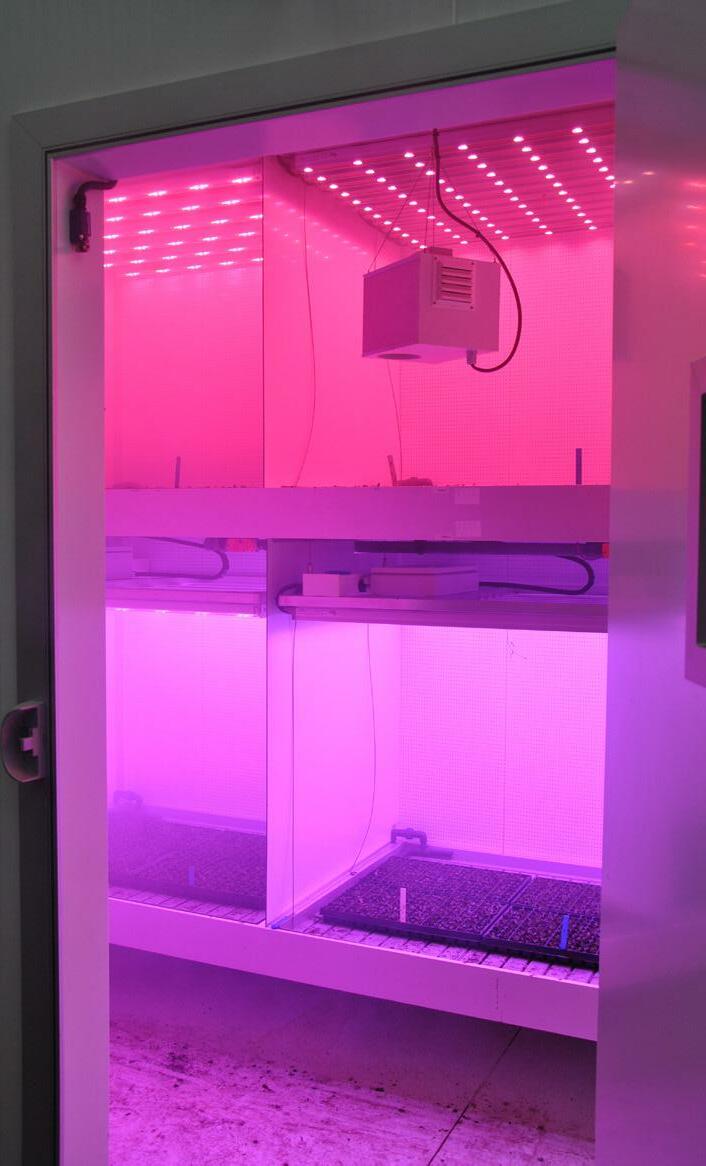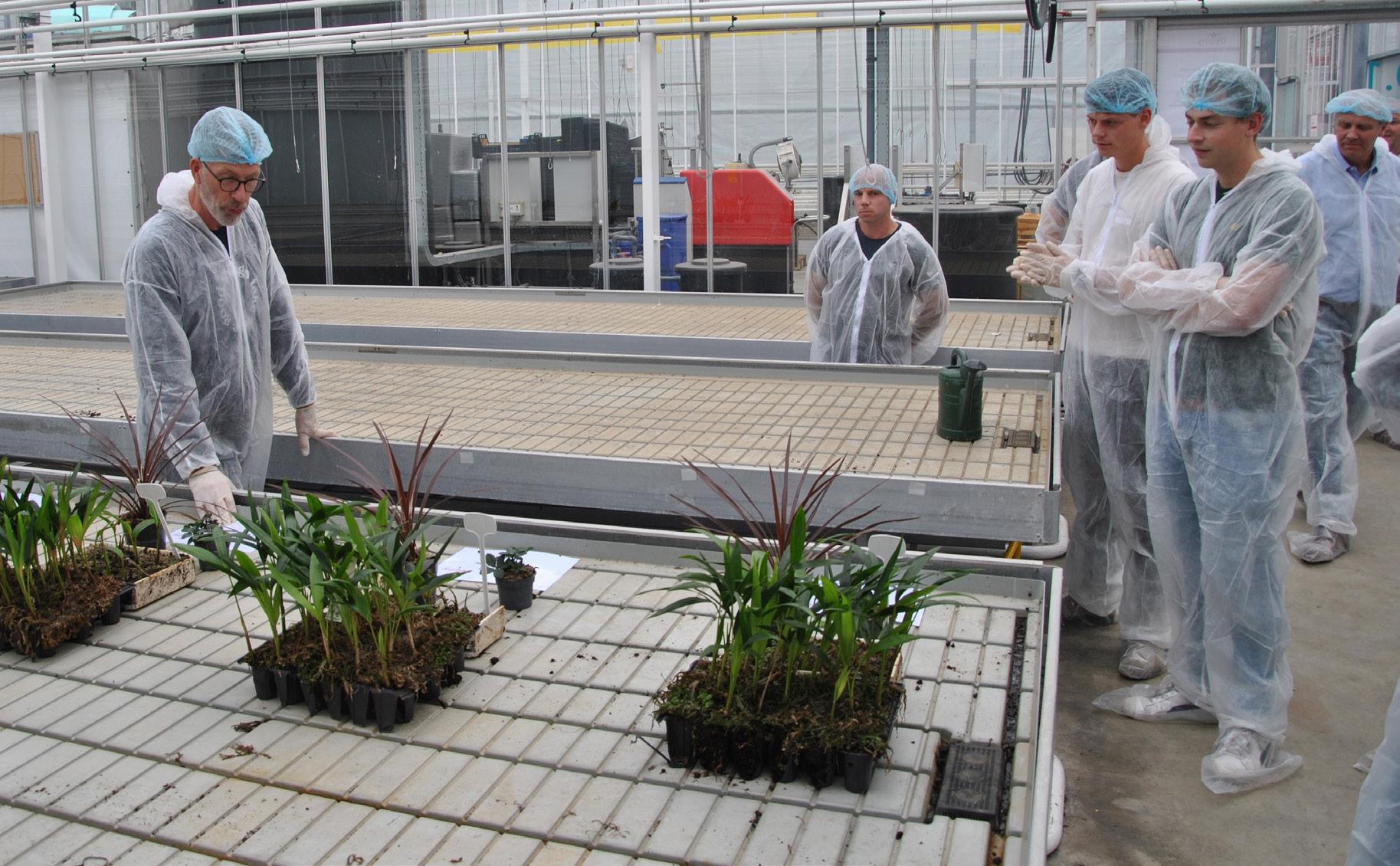
8 minute read
POTTED PLANTS
Delphy event talks about insect netting, bio fungicides and saving energy
Delphy’s Ms Lisanne HelmusSchuddeburg updated attendees about the preliminary outcome of a two-year LED trial in Phalaenopsis.
Advertisement
Delphy, the Dutch knowledgesharing organisation and service provider for cultivators worldwide, held a houseplant and bedding plant event at its Dutch-based Improvement Centre on 27 October 2022 to discuss the latest research findings on the relatively new Thrips parvispinus and the use of insect netting in potted plant production, plus introducing new bio fungicides products, and talking greenhouse energy efficiency.
AUTHOR: RON VAN DER PLOEG Delphy consultant and the afternoon’s moderator Erik de Rooi began the October event by referencing the current challenging economic climate. Many growers are on edge with a 16 per cent inflation rate, market volatility, and rising energy prices hampering consumer demand and confidence. This is why growers need to gauge the market’s mood and stay alert to their competitors, as well as research, technology and innovation that could positively change prospects.
INSECT NETTING IN POTTED PLANTS
Martijn Voorwinden, a Delphy crop technician focusing on flowering and green foliage plants and specialising in potted and cut Anthurium, presented some preliminary results of research carried out between 2 August and 2 November 2022. The findings were built on earlier work to investigate the feasibility of insect netting to control the dreaded pot worm found in Phalaenopsis cultivation. A trial was set up for Phalaenopsis, Poinsettia, Gerbera and Anthurium, putting the crops under 0.35mm and 0.85mm mesh netting. Scouting, monitoring and data loggers for temperature, humidity and light levels were used to quantify pest pressure. From the onset, the sticky cards showed much variation with significantly lower whitefly populations in Poinsettia and Gerbera and a build-up of an aphid colony in the crop next to the netting but not beneath it. Voorwinden also signalled a much weaker presence of caterpillars in the ‘netted crops’, which could stimulate biological control of other pests and diseases. Because so far, efficient caterpillar management requires repeat applications of chemicals, an obstacle when rolling out biocontrol strategies. Under mesh netting, Voorwinden noticed a higher relative humidity. In Gerberas, this resulted in moisture on leaf surfaces, larger foliage, and a higher incidence of downy mildew. Insect netting also makes it harder
for plant growth regulators (PGR) to enter the canopy. In the case of the Poinsettia, this can lead to 10cm taller plants. It is essential that the netting is laid out neatly over row crops and well anchored to avoid any gaps for insects to penetrate. Support hoops help secure the insect netting and protect the plants against netting snags and plant damage. In conclusion, Voorwinden highlighted the economic benefits of netting: it can lower the use of chemicals and bring about more perfect flowers and plants for the customer. Moreover, chemicals are often applied during evening hours when labour is more expensive. Insect netting is already commonly used in greenhouse construction when incorporated in vents. Voorwinden sees protective barrier mesh as a cheaper solution for existing greenhouse.
THRIPS PARVISPINUS
Thrips parvispinus is a tropical thrips species. It was first detected in the Netherlands in July 2019 and has become more widely established in plant nurseries throughout the Netherlands, Southern Europe and North America. The female T. parvispinus is darkcoloured, and the male specimens are yellow. Both males and females are small (females up to 1mm long), jumpy, and havoc-wreaking as they leave feeding scars on foliage. If they attack Anthuriums, they leave extensive brown scarring, causing malformation of foliage with loss of its symmetrical shape. This relatively new pest has a much more seclusive character than T. california; they escape attention by hiding away in the very heart of the crop where chemicals can hardly reach them. However, it has been shown that swaths of predatory mites such as Transeius montdorensis and Amblyseius swirskii seem effective in suppressing T. parvispinus populations in tropical foliage plants. In the long run, the legion of predatory mites may need auxiliary forces such as the predatory bug Orius laevigatus or the voracious larvae of Chrysoperla carnea, the green lacewing. Sticky cards in traditional yellow and blue work perfectly well; the green coloured ones as sold by Koppert seem to provide little added value. Sticky cards should be placed just above the crop canopy. Placed 40cm above the crop, the cards capture a few thrips, when placed higher the result is zero.
TAKEAWAYS FROM AMERICANHORT’S PLUG&CUTTING CONFERENCE
Delphy’s bedding plant technician Martijn Gevers was fresh back from the USA after attending the AmericanHort’s Plug & Cutting Conference 2022, held at the Westin Westminster in Denver between 19-21 September 2022. This event focused on best practices and cutting-edge research in young plant production, and Gevers was keen to share the insights with the gathered Dutch audience. On the other side of the big pond, chemical usage is more commonplace compared to Europe. Still, American growers are slowly but steadily moving towards a future with biological and natural alternatives to chemical control. Gevers anticipates that by 2030 there will be hardly any chemical crop protection left for Dutch horticulture, prompting young plant growers in the country to dive into what biological options are currently available. One of them is Prestop; a biological fungicide used to produce vegetables, fruits, herbs, and ornamentals. It is a naturally occurring, beneficial soil fungus that contains mycelium and spores of Gliocladium catenulatum. Prestop is a product made by the Lallemand group, a privately held Canadian company founded at the end of the 19th century, specialising in developing, producing, and marketing yeasts and bacteria. The bio fungicide can control a wide range of plant diseases, including grey mould and stem canker caused by Botrytis cinerea, damping off, crown and root rot diseases caused by Pythium, Rhizoctonia, Phytophthora and Fusarium, and wilt diseases caused by Fusarium and Verticillium. Prestop can be applied as a spray, drench, or fog through drip irrigation and incorporated into media and soil. The bio fungicide has a zero-hour restricted entry interval (REI) and has the seal of approval of the Organic Materials Review Institute (OMRI). German and Dutch cutting farms are

SPOTLIGHT ON PLANT LIGHTING TRIALS
Ms Lisanne Helmus-Schuddebeurs updated the attendees about the preliminary outcome of a two-year LED trial in Phalaenopsis.
In the trial, Plant Lighting and Delphy studied CO2, light and temperature levels in 5,500 Phalaenopsis plants grown under full, dimmable LEDs in a 150m2 glasshouse. No minimum pipe temperature was used.
The baseline for comparison was a same-size greenhouse with Phalaenopsis under highpressure sodium lights (HPS). The Phalaenopsis - a plant using Crassulacean Acid Metabolism (CAM) photosynthesis that allows the plant to open its stomata at night instead of during the day – in ten different varieties, showed consistency at the end of the trials with no differences in weight.
The shoots in the control test, however, were heavier. The same applied to the roots of the plants under LEDs, which most likely can be explained by the reduced heat in the LED greenhouses.
More study is needed to make a conclusion, but at first sight, there seem to be no differences in crop times and plant quality which may be good news.
In another trial, Delphy studied how to eradicate Marchantia polymorpha (liverwort).

DELPHY: THE ESSENTIALS
Delphy – derives its name from the classic antiquity Delphi, where people met with questions about crops, fertility, and harvest - is an independent, knowledge-sharing organisation, research institute and crop consultancy firm active in fruit, vegetables, and ornamentals.
Delphy operates from wholly owned research sites, with the Bleiswijk-based Improvement Centre occupying pride of place. Current research projects in ornamental horticulture include fossil-free bedding plant cultivation and sustainably grown Phalaenopsis, the perfect Chrysanthemum and the perfect Rose.
Delphy provides training sessions in situ and employs 250 people, of which 85 work abroad. using the product since five years to combat Botrytis and Rhizoctonia in Poinsettias and fungus in Hydrangeas. In a pansy trial, Prestop scored nearly as well as Previcur. Gevers notes that bio fungicides must be applied preventatively and won’t work after disease invasion. They must therefore be used before the infection has had a chance to develop so that the beneficial fungi can become established and attack any newcomer disease pathogens. It is also crucial to check the greenhouses’ spore pressure and disinfest all propagation tools and materials, including plant trays. Moreover, bio fungicides must be applied in the right conditions to optimise performance. Global fertiliser business ICL, for example, informs on its website that if soil wetness and air temperatures are conducive to disease development, they’re equally suited to applying Prestop. For example, aerial growth of Botrytis cinerea is optimised at 18-22°C, while soil pathogens causing damping off and root rot prefer 15-20°C pre-emergence and 22-27°C post-emergence. Lalstop is another preventative product using the naturally occurring bacteria Streptomyces. None of the attendees is currently using the product, contrary to Prestop. The product controls a wide range of pathogens, including damping-off caused by fungi such as Alternaria and Rhizoctonia solani, and wilt and root diseases caused by Fusarium, Phytophthora and Pythium. When applied as a drench or spray, the dried spores and mycelium of the Streptomyces culture in Lalstop germinate and grow on and around the plant root system. This creates a biological defence against seed and soil-borne pathogens. Configure is a widely known PGR in the USA and the Netherlands. It is predominantly used in Dutch Phalaenopsis production and has potential in bedding plant production. Configure increases lateral branching and flowering in several popular ornamental species. In addition, applications of Configure may reduce the height of treated plants, resulting in more compact and marketable crops. Configure is labelled for use on containerised annual and perennial flowering, foliage crops, and tropical plants. More recently, flower food providers










